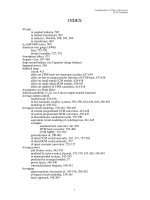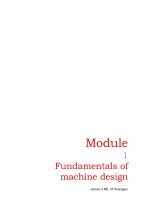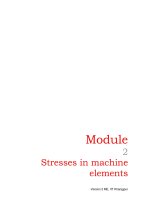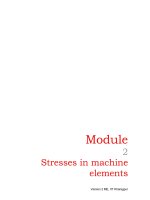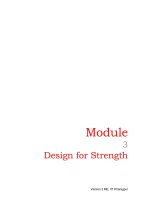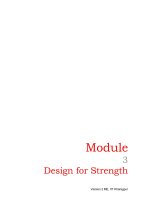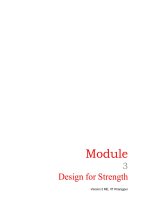Tài liệu Fundamentals of Machine Design P3 pptx
Bạn đang xem bản rút gọn của tài liệu. Xem và tải ngay bản đầy đủ của tài liệu tại đây (113.2 KB, 13 trang )
Module
1
Fundamentals of
machine design
Version 2 ME, IIT Kharagpur
Lesson
3
Brief overview of design
and manufacturing
Version 2 ME, IIT Kharagpur
Instructional Objectives:
At the end of this lesson, the students should be able to understand:
• Concept of limits and fits
• Preferred numbers
• Various manufacturing processes
1.3.1 Design and Manufacturing
A machine element, after design, requires to be manufactured to give it a shape
of a product. Therefore, in addition to standard design practices like, selection of
proper material, ensuring proper strength and dimension to guard against failure,
a designer should have knowledge of basic manufacturing aspects.
In this lesson, we will discuss briefly about some of the basic manufacturing
requirements and processes.
First and foremost is assigning proper size to a machine element from
manufacturing view point. As for example, a shaft may be designed to diameter
of, say, 40 mm. This means, the nominal diameter of the shaft is 40 mm, but the
actual size will be slightly different, because it is impossible to manufacture a
shaft of exactly 40 mm diameter, no matter what machine is used. In case the
machine element is a mating part with another one, then dimensions of both the
parts become important, because they dictate the nature of assembly. The
allowable variation in size for the mating parts is called limits and the nature of
assembly due to such variation in size is known as fits.
1.3.2 Limits
Fig. 1.3.1 explains the terminologies used in defining tolerance and limit. The
zero line, shown in the figure, is the basic size or the nominal size. The definition
of the terminologies is given below. For the convenience, shaft and hole are
chosen to be two mating components.
Version 2 ME, IIT Kharagpur
Tolerance
Tolerance is the difference between maximum and minimum dimensions of a
component, ie, between upper limit and lower limit. Depending on the type of
application, the permissible variation of dimension is set as per available
standard grades.
Tolerance is of two types, bilateral and
unilateral. When tolerance is present on
both sides of nominal size, it is termed
as bilateral; unilateral has tolerance only
on one side. The Fig.1.3.2 shows the
types of tolerance.
50
is
a typical example of specifying tolerance
for a shaft
0x
y0
x
y
50 and 50
++
−−
,
of nominal diameter of 50mm. First two values denote unilateral tolerance and
the third value denotes bilateral tolerance. Values of the tolerance are given as x
and y respectively.
Allowance
It is the difference of dimension between two mating parts.
Upper deviation
It is the difference of dimension between the maximum possible size of the
component and its nominal size.
Basic size
Unilateral Bilateral
Fig. 1.3.2 Types of tolerance
Max.
Diameter
(upper limit)
Min. Diameter
HOLE
(lower limit)
Tolerance
SHAFT
Basic Size
Lower
Deviation
Upper
Deviation
ZERO LINE
Allowance
Fig. 1.3.1 Interrelationship between tolerances and limits
Version 2 ME, IIT Kharagpur
Lower deviation
Similarly, it is the difference of dimension between the minimum possible size of
the component and its nominal size.
Fundamental deviation
It defines the location of the tolerance zone with respect to the nominal size. For
that matter, either of the deviations may be considered.
1.3.3 Fit System
We have learnt above that a machine part when manufactured has a specified
tolerance. Therefore, when two mating parts fit with each other, the nature of fit is
dependent on the limits of tolerances and fundamental deviations of the mating
parts. The nature of assembly of two mating parts is defined by three types of fit
system, Clearance Fit, Transition Fit and Interference Fit. The fit system is shown
schematically in Fig.1.3.3.
There are two ways of representing a system. One is the hole basis and the
other is the shaft basis. In the hole basis system the dimension of the hole is
considered to be the datum, whereas, in the shaft basis system dimension of the
shaft is considered to be the datum. The holes are normally made by drilling,
followed by reaming. Therefore, the dimension of a hole is fixed due to the nature
of the tool used. On the contrary, the dimension of a shaft is easily controllable
by standard manufacturing processes. For this reason, the hole basis system is
much more popular than the shaft basis system. Here, we shall discuss fit
system on hole basis.
Version 2 ME, IIT Kharagpur
